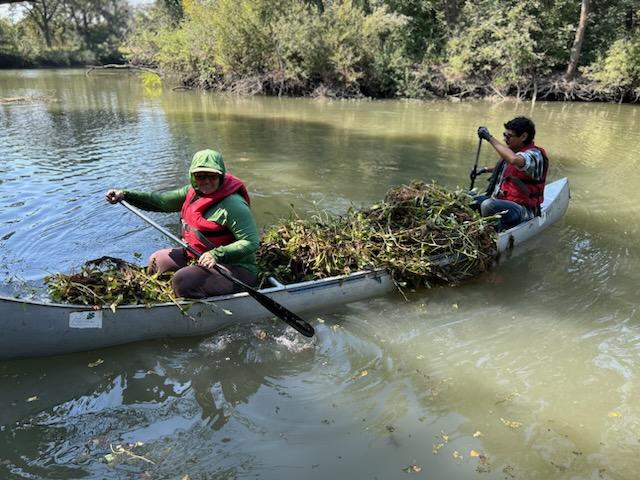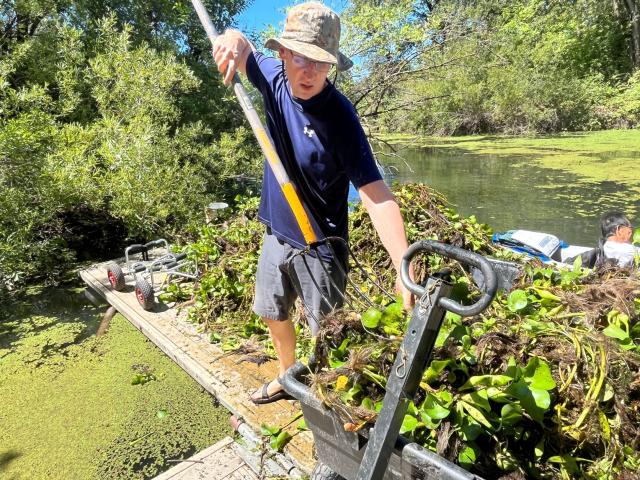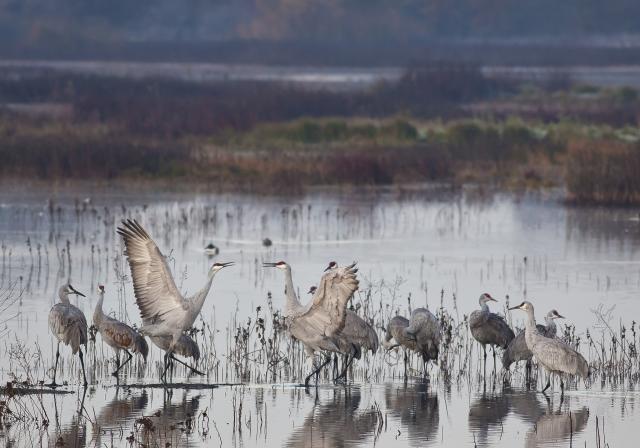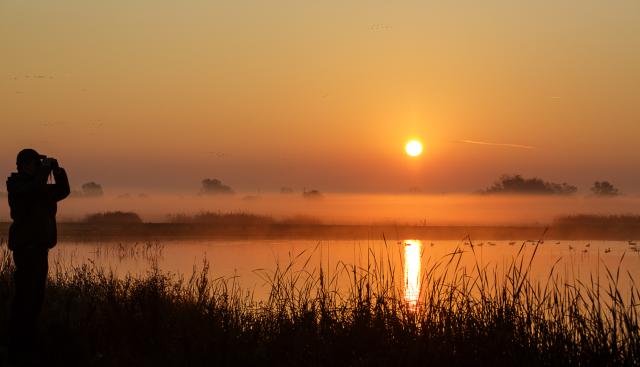Partnerships are key to success in Cosumnes Watershed
Listen
Subscribe
Related Content
The Bureau of Land Management is a partner with many other organizations and landowners -- public, private, and non-profit -- in managing the Cosumnes Watershed. The 46,000-acre Cosumnes River Preserve is an important stopping point for migratory birds, and a beloved recreation area for people living in California's Central Valley near Sacramento.
Amy Fesnock is the BLM's Cosumnes River Preserve manager in Galt, California. BLM received $76,000 from the Bipartisan Infrastructure Law and more than $7.5 million from the Inflation Reduction Act for landscape restoration. BLM and its partners plan a variety of projects at the site, from improving the habitat for the threatened giant garter snake, to providing environmental education and growing native seedlings for replanting with local school children. In this interview, Fesnock speaks to the vital role that partnerships play in the success of improving the river's landscape.
Transcript
[NARRATOR: David Howell, BLM]: The Cosumnes River flows through Sacramento County, California, and parts of it have been protected near the city of Galt. The river is located on a dynamic floodplain that is an essential waterway for fish and other aquatic species. The wetlands provide a critical rest stop for migrating birds.
I’m David Howell, and you’re listening to On The Ground, a Bureau of Land Management podcast. Across the Cosumnes Watershed, BLM received $70,000 from the Bipartisan Infrastructure Law, and more than $7.5 million from the Inflation Reduction Act. I recently sat down with Amy Fesnock, BLM’s manager of the Cosumnes River Preserve, to talk about the river and her plans for that financial investment.
[Amy Fesnock, BLM Cosumnes River Preserve Manager]: In California, The Cosumnes River is the last free river that flows out of the Sierra Nevada. All the other rivers that come out of the Sierra have some sort of water diversion or dam system set up and Cosumnes doesn't. So when it comes to how this river behaves it is very prone to flooding, and in that natural state it really gives us a chance to see how the habitat and how that kind of natural process historically worked.
[Howell]: I was looking at the map a little earlier and I see that BLM has some spots of ground out there within this giant polygon that we call the watershed. It doesn't look like we're the majority landowner out there by any stretch. So what makes our efforts have such an impact within that polygon?
[Fesnock]: Well, so that's actually another aspect that makes the Cosumnes River Preserve and this Cosumnes watershed such an inspirational or unique project area, is that it's based on partnerships. The Cosumnes River Preserve Partnership started in the mid-1980s between The Nature Conservancy and Ducks Unlimited with BLM joining in that, and then slowly over the next handful of years or a decade, we have continued to add partners like the California Department of Fish and Wildlife or the California Department of Water Resources, [the California] State Lands Commission, the Galt Joint Elementary School District, [Sacramento] County.
We're a partnership of 10 different organizations or agencies. And with that partnership, we work collaboratively to manage the 53,000 acres that equals the Cosumnes River Preserve. If I look at that entire watershed, we have additional partners that aren't part of the official partnership at the preserve itself. There's just a lot of people that are interested in protecting this natural landscape, ensuring that there's connectivity, ensuring that the Cosumnes can continue to be that free, wild river that it is. And BLM is just one of many, and it's that working together that I think makes this place special and is what allows us to do the great things that we're doing.
[Howell]: So we're getting money from the Bipartisan Infrastructure Law and from the Inflation Reduction Act to be doing some work there; maybe give me a just a little bit of an overview of some of the projects that you have in mind.
[Fesnock]: Absolutely! So we have, we have a several key project areas or emphasis that that fit within this restoration landscape. One is control or management of exotic species. Some of those exotic species are aquatic like primrose and water hyacinth. Those are important to manage in order to protect the wetlands and the rivers and sloughs that make up the preserve, especially in the lower Delta region.
We have a population of giant Garter snakes, which is an endangered…federally and state listed endangered species.
We have state-listed Swainson's hawk, which is a California-unique raptor species similar to a red tailed or red shouldered hawk. Swainson's hawks spend their summers up here in the Central Valley of California and their winters down in South America…
[Howell]: Wow! That’s a trip!
[Fesnock]: Yes, it is! It's one of our focal species here, so it… we have some projects where we're working to expand the protection of the nesting habitat that Swainson’s hawks need to be successful in their breeding time up here.
We have projects working with the Galt Joint [Union] Unified Elementary School District where we get students from K through 12 out at the preserve, learning about the ecosystem, collecting native seeds, planting native seeds, growing seedlings, and then coming back and planting those back out in the environment, to really connect those local populations to this area and understanding how we're all connected and how much work there needs to be done in order to maintain and keep this ecosystem properly functioning.
There's just so many things going on in this watershed that we're very grateful to have the funding from BIL and IRA to be able to implement on the ground.
[Howell]: Yeah, that sounds like a lot going on. Earlier you mentioned partner organizations. Can you tell me how they are enhancing some of the work you are doing?
[Fesnock]: Absolutely. If I look at the amount of work that needs to be done in this watershed, it would be impossible for BLM to do it on our own. And it really is that partnership, that long term partnership, that really allows us to have a greater reach and greater dynamic. So if I talk about our control of exotic plants, the water primrose, the hyacinth – the terrestrial Issues, you know, yellow star thistle, Italian thistle, fennel, those kinds of things – yes, BLM is actively participating in that; the California Department of Fish and Wildlife and The Nature Conservancy are also helping battle those pest species, those noxious, invasive weeds on their lands, which make up part of the preserve.
If I think about the improvement or the enhancement that we're doing for our wetlands, some of that work is being done on The Nature Conservancy lands. Some of that work is being done with the help or the assistance of another partner of ours, Ducks Unlimited. Without the knowledge and expertise that Ducks Unlimited has on constructing and maintaining and enhancing wetlands, it would be a lot harder for me to be able to implement that. So having a partner that has that kind of knowledge and expertise, and then the willingness to share that knowledge and expertise, is really what makes this place such an amazing area to work in.
Our visitor-ship continues to increase, and people get to know about us more and they can take a rest from the congestion and city life that they are in. And come down and go for a lovely walk or paddle at the preserve and just really connect to that natural environment and that's what I hope we continue to expand.
[Howell]: That sounds like a great place.
[Fesnock]: I love it here! I count my blessings every day. Even when there are hard things that have to be done, I am so grateful to be able to be a part of this place.
[Howell]: Amy Fesnock is the BLM Manager of the Cosumnes River Preserve in Galt, California. We’ll have photos of the work that she and others are doing in the Preserve on our website.
I’m David Howell, thanks for joining me On The Ground.





